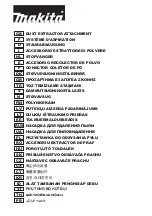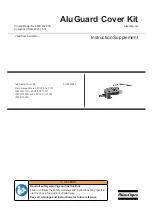
9
8
or holes are found replace burner. IMPORTANT:
Burner opening must slide over valve nozzle.
9. Orient the burner CORRECTLY by positioning the
burner opening onto the valve and installing
the screw to secure the burner in place.
10. Replace screw on the burner and follow the
“Gas Leak Testing” section of this manual.
Relight burners to verify proper operation.
11. Replace heat distribution plates and cooking
grills.
Proper Care & Maintenance
• To protect your grill from excessive rust, the unit
must be kept clean and covered at all times
when not in use.
• Wash cooking grills and heat distribution plates
with hot, soapy water, rinse well and dry. Lightly
coat cooking grill with vegetable oil or vegetable
oil spray.
• Clean inside and outside of grill by wiping
off with a damp cloth. Apply a light coat of
vegetable oil or vegetable oil spray to the
interior surface to prevent rusting.
• The stainless steel exterior surface of your grill,
can be cleaned with stainless steel cleaner.
• Never apply paint to the interior surface. Rust
spots on the interior surface can be buffed,
cleaned, then lightly coated with vegetable oil or
vegetable oil spray to minimize rusting.
Cleaning and Maintenance
Correct care and maintenance will keep your
appliance operating smoothly. Clean regularly as
determined by the amount of use. NOTE: Clean
the entire appliance each year and tighten all
hardware on a regular basis (1-2 times a year or
more depending on usage). Cleaning should be
done where detergents won’t harm patio, lawn, or
the like.
Cooking Grates
• When cool, wash your cast iron thoroughly with
are at the desired temperatures to sear the food
sugars when cooking. After lighting your grill,
set the main burner control knobs to the “HIGH”
position for 5 to 10 minutes.
Controlling Flare-Ups
• Flare-ups are a part of cooking meats on a gas
grill. This adds to the unique flavor of cooking
on a gas grill. Excessive flare-ups can over-cook
your food and cause a dangerous situation for
you and your grill. Excessive flare-ups result
from the build-up of grease in the bottom of
your grill. If this should occur, DO NOT pour
water onto the flames. This can cause the
grease to splatter and could result in serious
burns or bodily harm.
To Minimize Flare-Ups
• Trim excess fat from meats prior to cooking.
• Cook meats with high fat contents (chicken or
pork) on Low settings or indirectly.
• Ensure that your grill is on level ground and the
grease is allowed to evacuate the grill through
the drain hole in the bottom and into grease
cup.
Cleaning The Burner
NOTE: Spiders and small insects can spin webs
and build nests inside the burner. This especially
occurs in late summer and fall before frost when
spiders are most active. These nests can obstruct
gas flow and cause a fire in and around the
burner and orifice. Such a fire can cause operator
injury and serious damage to the appliance. To
help prevent a blockage and ensure full heat
output, clean and inspect burner tube often (once
or twice a month). NOTE: Water or air pressure will
not normally clear a spider web.
WARNING
All cleaning and maintenance should
only be done when the appliance is cool
and with the fuel supply turned off at
the LP cylinder. DO NOT clean any part
in a self-cleaning oven. The extreme
heat will damage the finish.
Burner Assembly/Maintenance
• Although your burner is constructed of stainless
steel, it may corrode as a result of the extreme
heat and acids from cooking foods. Regularly
inspect the burner for cracks, abnormal holes,
and other signs of corrosion damage. If found,
replace the burner.
• DO NOT obstruct the flow of combustion and
ventilation air. Burner tubes can become
blocked by spiders and other insects building
their nests. Blocked burner tubes can prevent
gas flow to the burners and could result in
a burner tube fire or fire beneath the grill.
To clean the Burner Assembly follow these
instructions to clean and/or replace parts of
burner assembly or if you have trouble igniting
the grill.
1. Turn gas off at control knobs and LP cylinder
tank valve.
2. Remove cooking grills and heat distribution
plates.
3. Remove screw from the burner “foot” using a
screwdriver.
4. Carefully lift the burner up and away from valve
opening.
5. Use a narrow bottle brush or a stiff wire bent
into a small hook to run through the burner
tube and flame port several times.
Debris
Note: Wear eye protection when performing
procedure 6.
6. Use compressed air to blow into burner tube
and out the flame ports. Check each port to
make sure air comes out each hole.
7. Wire brush entire outer surface of burner to
remove food residue and dirt.
8. Check burner for damage, if any large cracks
a non-citrus based soap and water. Be sure
to rinse and dry completely. (Note: Soap can
remove the seasoning of your cast iron if you
don’t restore it after cleaning.)
Heat Distribution Plates
• Periodically, it may be necessary to inspect and
clean the heat distribution plate to prevent
excess grease build-up. When the grill is cold,
remove the cooking grills. Inspect the heat
distribution plates and replace if broken or
damaged. Do not allow heat distribution plates
to become damaged to the extent that they may
fall through onto the burners. Replace the heat
distribution plates and cooking grills and light
the burners. Operate the grill on “HIGH” for 10
minutes to remove the excess grease.
Suggested Cleaning Materials
• Mild dish washing liquid detergent
• Wire brush
• Nylon cleaning pad
• Hot water
• Paper clip
• Soft brass bristled brush
Component Cleaning
• BURNER: Wire brush loose corrosion from burner
exterior. Clean clogged gas port holes with
an opened paper clip. Replace corroded or
damaged burners that would emit excess gas.
• After the appliance has cooled, wipe areas
where paint and finish have burned off to
minimize rusting.

























